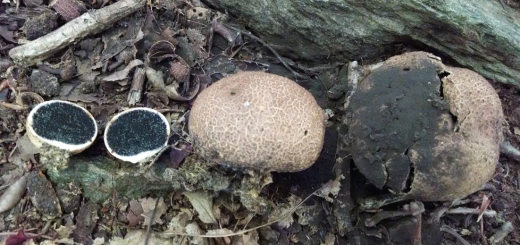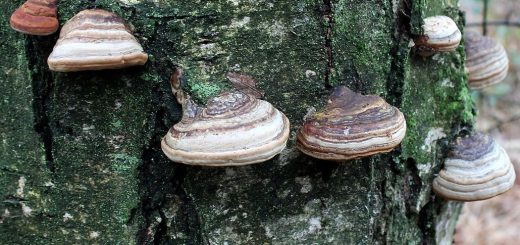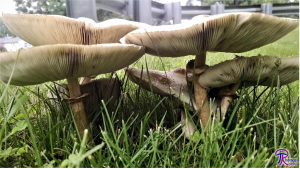#108: Heimioporus betula, the Shaggy-Stalked Bolete
Noting what decorations a bolete has on its stem can be very helpful in identifying that bolete. One type of decoration you may find on a bolete’s stipe is reticulation. Reticulation is a net-like pattern of ridges that extend partially or all the way down the stipe. These ridges are actually an extension of the pore surface, much like decurrent gills in agarics. The reticulum does produce spores, but is not as efficient at discharging spores because it is oriented parallel to the ground. Heimioporus betula is hands-down the best example of reticulation in any bolote.
H. betula is easily identified by its outrageous reticulation. The ridges can easily extend 5mm or more from the surface of the stipe. This reticulation is most impressive when the mushroom is young, since the ridges make the stipe as wide as – or even wider than – the cap! The reticulum is yellow but becomes red with age. H. betula is a fairly large mushroom, with a pileus that is 3-9cm (1-3.5in) wide and a stipe that is 10-30cm (4-12in) long and 1-2.5cm (0.4-1in) thick when mature. The stipe surface is yellow near the cap and fades to red towards the base. H. betula’s cap is its least impressive feature. Above, the cap is yellowish to orangish to reddish to reddish brown. It is convex, is smooth, becomes somewhat pitted with age, and is slimy when fresh and wet but shiny when dry. Underneath, the cap features a yellow to yellow-green pore surface composed of medium-sized (1-2 per millimeter), angular (the edges are straight lines rather than true circles) pores. The pore surface is often sunken towards the center, where the stipe is attached. The flesh of the mushroom is yellow but may have reddish patches in the stipe. No areas on H. betula bruise when sliced. This mushroom’s spore print is olive to olive-brown.
Thanks to this mushroom’s large size and bright colors, it is easy to spot in the forest. H. betula is mycorrhizal with oaks and pines, so it can be found on the ground in many areas of Eastern North America. It is particularly fond of oak-pine forests in the southern Appalachians. A few to many, individual mushrooms will fruit scattered across a wide area. Look for this mushroom from late summer through fall.
There are a couple other North American mushrooms that resemble H. betula. Boletellus russellii can be distinguished by its dry, scaly cap and (for those of you with a microscope) its longitudinally ridged spores. Boletus projectellus can be distinguished by its brownish cap and much thinner reticulation. Both of these mushrooms can be found in Eastern North America. Luckily H. betula, B. russellii, and B. projectellus are all edible (but do not have a distinctive flavor).
See Further:
http://www.mushroomexpert.com/heimioporus_betula.html
http://www.mushroomexpert.com/boletus_illudens.html#reticulation









![#011: Characteristics of Kingdom Fungi [Archived]](https://www.fungusfactfriday.com/wp-content/themes/hueman/assets/front/img/thumb-small-empty.png)


1 Response
[…] stipe, nothing else in North America can be mistaken for B. frostii.3 Heimioporus betula (FFF#108) also has a deeply reticulate stipe but features lighter colors and yellow pores.4 The most similar […]